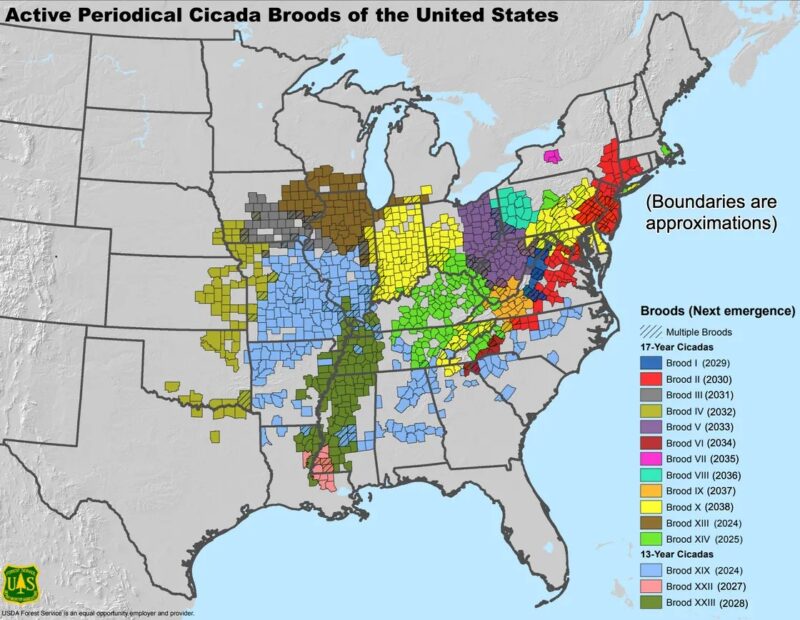Behold the red-eyed pharaoh cicada (Magicicada septendecim), during an emergence in 2016. In spring 2024 – in an event that happens only once every 221 years – 2 of the largest broods of cicadas will emerge at once. This double emergence will feature Brood XIII (consisting of 3 species, including the cicada seen here) and Brood XIX (4 species). Image via Pexels/ Michael Kropiewnicki.
Spring 2024 is is going to be the season of the cicada
- Researchers predict the emergence of trillions of cicadas across the eastern U.S. this spring.
- Cicadas follow 13- and 17-year cycles. This rare double cicada mega-brood emergence happens only once every 221 years.
- Cicadas are harmless to humans. Though sometimes confused with locusts, their potential harm to plants isn’t too serious. No need to break out the insecticides. On the other hand, cicadas can be loud. Their buzzing reaches up to 106.7 decibels.
Researchers at the University of Connecticut are predicting the emergence of trillions of cicadas – the red-eyed, chirping, winged insects – across the United States this spring. But don’t worry. They won’t all be coming out at once or in the same region.
Cicadas – members of the order Hemiptera along with stink bugs, bed bugs and aphids – spend as long as 17 years underground before emerging as adults. This year, the bugs will dig their way to freedom across 1.5 million acres throughout the Eastern U.S., an area roughly the same size as the state of Delaware.
The UConn researchers describe it this way:
If we accept an estimate of a million cicadas per acre and if the total combined area of a periodical cicada emergence is roughly the size of Delaware, then more than a trillion cicadas will be involved. For 2024, since cicadas will emerge from Maryland to Oklahoma, Illinois to Alabama, clearly, trillions of adult cicadas will be present – but not all in the same place at the same time.
UConn
Some cicadas will emerge as early as March, but the big coming-out will be in April and May, depending on the weather.
CicadaSafari.org says 2024 will be a banner year for cicadas, as two of the biggest broods will emerge at the same time in bordering areas of the Midwest:
The 17-year Brood XIII will emerge in Northern Illinois, while the 13-year Brood XIX will emerge in parts of Southeastern United States. It is not common to have a dual emergence between Broods XIII and XIX. They occur once every 221 years, and the last time these two broods emerged together was in 1803.
In 1803, Thomas Jefferson was President of the United States, and Lewis and Clark started their exploration of the Louisiana Purchase.
The areas where Brood XIII and Brood XIX occur mostly don’t overlap, according to the cicada experts at UConn. However, there could be small areas where both broods are active:
The greatest likelihood of contact between these broods is around Springfield, Illinois. … While there may be scattered woods in which both broods are present, there will be no broad overlap, and it will be impossible, in 2024, to identify any areas of overlap, large or small.
CicadaSafari.org offers tips on where to see cicadas, all kinds of cicada facts and figures, and has a cicada tracking app so amateur entomologists can get in on the cicada action.

Here are the active periodical cicada broods in the United States. The 2 broods emerging in spring 2024 are Brood XIII (brown) in northern Illinois and Brood XIX (light blue) scattered across the Midwest and southeast. Image via U.S. Forest Service/ Wikimedia Commons (public domain).
Cicadas are subterranean math wizards
A common misconception is cicadas are a kind of locust or grasshopper. They aren’t. With their large red eyes and long body, cicadas do resemble locusts but instead are “true insects” of the order Hemiptera.
Cicadas appear on every continent but Antarctica. There are 190 varieties of cicada in North America, and about 3,400 varieties recorded worldwide so far. Some kinds of cicadas appear every year, while the periodic cicadas appear on 13- and 17-year cycles.
As fryrsquared explains via TikTok, 13 and 17 are prime numbers that can’t be factored. This means Brood XIII with its 17-year cycle and Brood XIX with its 13-year cycle can only emerge together every 221 years.
Don’t spray the cicadas!
Cicadas are loud but basically harmless to humans and the environment, so there’s no need to break out the insecticide. When they emerge, the only thing they’re interested in is mating and laying eggs, says UConn:
icadas do not possess special defensive mechanisms — they do not sting or bite. The ovipositor is used only for laying eggs and the mouthparts are used only for feeding on twigs; thus, periodical cicadas can hurt you only if they mistake you for a tree branch!
Cicadas will fly off when they feel threatened, and the males will make their iconic buzz. That buzz – produced when males flex drum-like organs called tymbals – is loud, reaching up to 106.7 decibels, about the same as a chain saw.
The male cicadas sing during the day to attract females. Dog-day (annual) cicadas tend to sing more in late afternoon and evening. Each cicada species has its own distinctive sound to avoid attracting the wrong cicada. Typically, periodical cicada emergences consist of three species, that can be distinguished by the male songs as well as by slight differences in their appearance. The nymphs of these cicadas feed on the roots of trees and shrubs.
Bottom line: Trillions of harmless cicadas will emerge in the Eastern U.S. this spring. The song of the cicadas may be loud, but the insects are basically harmless.
EARTH SKY http://Cicadas Insect

Leave a Reply
You must be logged in to post a comment.